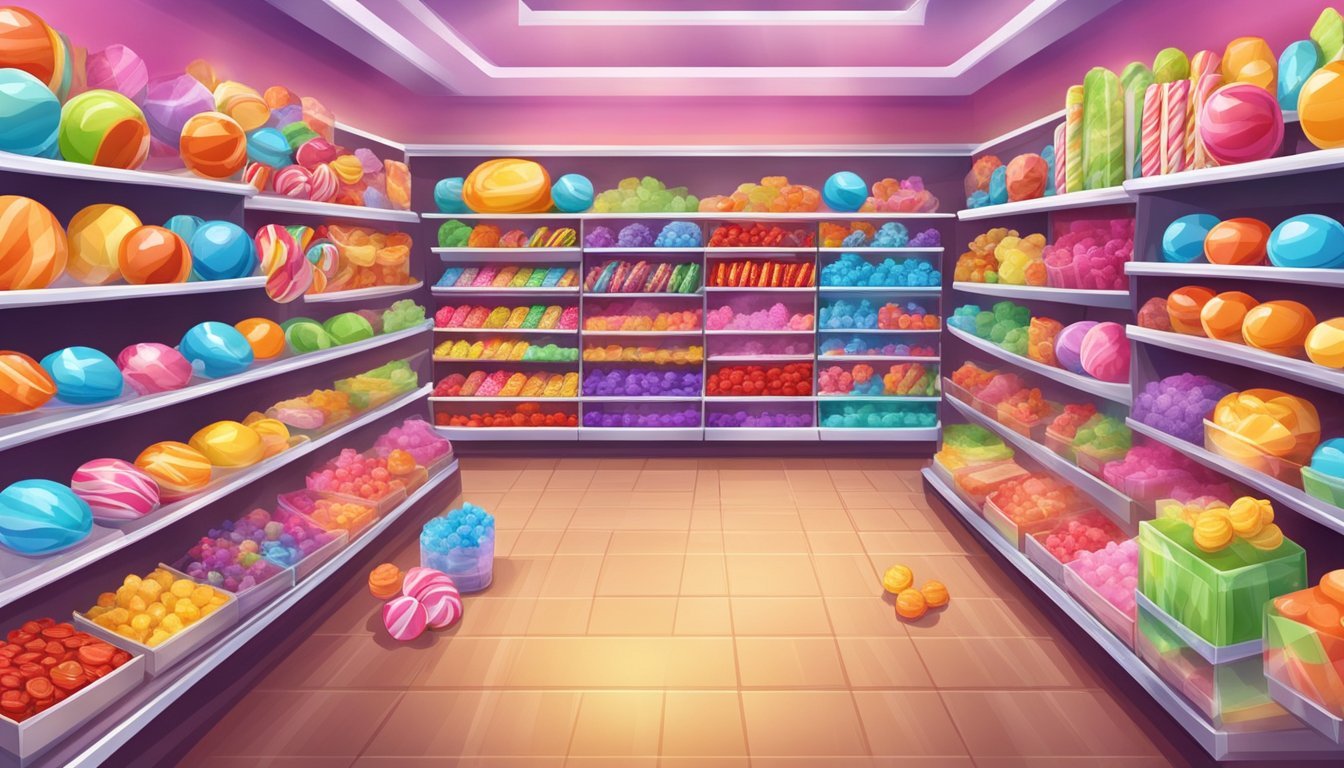Sweet Tooth Paradise: Unveiling the Best Grocery Stores for Candy Lovers
Grocery stores offer more than just everyday essentials. For candy lovers, certain chains have become destinations for sweet treats. These stores stock a wide variety of confections, from classic favorites to unique international brands.
Target stands out as a top choice for candy enthusiasts, offering an extensive selection that includes popular brands, seasonal specialties, and their own in-house chocolate line. The retailer's candy aisle features everything from nostalgic penny candies to premium European chocolates, catering to diverse tastes and preferences.
Aldi also deserves recognition for its candy offerings. The German grocery chain is known for its rotating selection of seasonal sweets and high-quality European chocolates at affordable prices. Shoppers can often find unique flavors and candies not commonly available in other U.S. stores, adding an element of excitement to candy shopping.
The Importance of Quality in Candy Selection
Quality ingredients and production methods are crucial factors in creating exceptional candy. They directly impact taste, texture, and overall enjoyment. Conscientious consumers increasingly seek out candies made with premium components and ethical practices.
Identifying Quality Ingredients
High-quality candies use natural flavors and colors derived from fruits, vegetables, and spices. Artificial additives are often avoided. Premium chocolate contains real cocoa butter rather than vegetable oil substitutes. Quality gummy candies use real fruit juice for flavoring.
Sugar alternatives like honey or maple syrup may be used in place of refined sugar. Organic and non-GMO ingredients are becoming more common in upscale candies. Some manufacturers highlight their use of fair trade cocoa or vanilla.
Reading ingredient labels carefully helps identify superior candies. Shorter lists with recognizable components generally indicate higher quality. Artificial preservatives, colors, and flavors are red flags for many discerning candy lovers.
Impact of Cocoa Content on Chocolate
Cocoa content significantly affects chocolate's flavor, texture, and nutritional value. Higher percentages of cocoa solids create more intense, complex flavors. Dark chocolate with 70% or more cocoa offers a rich, slightly bitter taste profile.
Cocoa content also influences health benefits. Dark chocolate contains more antioxidants and less sugar than milk chocolate. However, very high cocoa percentages can be too bitter for some palates.
Quality chocolatiers carefully select and blend cocoa beans from different regions. This creates unique flavor profiles. Single-origin chocolates showcase the distinct taste of beans from one location. Cocoa percentage alone doesn't guarantee quality - bean selection and processing methods are equally important.
Organic vs. Conventional Candy
Organic candy is made without synthetic pesticides, fertilizers, or genetically modified ingredients. It often contains fewer additives and preservatives. Some consumers prefer organic candy for environmental or health reasons.
Organic dark chocolate may have higher levels of beneficial antioxidants. This is due to different farming practices. However, organic certification doesn't automatically mean a candy is healthier or tastier.
Conventional candy can still be high-quality if made with premium ingredients. Some artisanal candymakers use conventional ingredients but focus on natural flavors and colors. The choice between organic and conventional often comes down to personal preferences and priorities.
Both types can be found in well-stocked candy aisles. Specialty stores and upscale grocers typically offer a wider selection of organic options.
Variety and Assortment in Grocery Stores
Grocery stores offer a wide range of candy options to satisfy every sweet tooth. From classic chocolate bars to gummy treats, the selection caters to diverse tastes and preferences.
Understanding Chocolate Varieties
Chocolate lovers can find an array of options in most grocery stores. Milk chocolate bars, with their creamy texture, appeal to those who prefer a sweeter taste. Dark chocolate varieties, ranging from 50% to 90% cocoa content, cater to those seeking a more intense flavor.
White chocolate, made from cocoa butter without cocoa solids, offers a unique sweetness. Many stores stock premium brands alongside popular favorites, allowing customers to explore different cocoa percentages and flavor profiles.
Specialty chocolates with nuts, fruits, or caramel fillings provide exciting taste combinations. Some grocers even offer single-origin chocolates for connoisseurs interested in distinct flavor notes from specific cocoa-growing regions.
Non-Chocolate Candy Options
Gummies come in various shapes, flavors, and textures. Fruit-flavored gummies, sour-coated varieties, and even vitamin-enriched options are common finds. Taffy, with its chewy consistency, is available in classic flavors like vanilla and strawberry, as well as more adventurous combinations.
Hard candies offer long-lasting flavor, while lollipops provide a fun eating experience. Licorice, in both traditional black and fruit-flavored red varieties, is a staple in many candy aisles.
Sugar-free options cater to those watching their sugar intake. These alternatives use sugar substitutes to mimic the taste and texture of regular candy while providing fewer calories.
Seasonal and Festive Offerings
Grocery stores adapt their candy selections to match holidays and seasons. Easter brings an influx of chocolate bunnies, cream-filled eggs, and jelly beans. Pastel-colored candies and marshmallow treats also make appearances during this time.
Halloween sees an increase in individually wrapped candies perfect for trick-or-treating. Christmas introduces peppermint-flavored treats, chocolate Santas, and candy canes.
Valentine's Day features heart-shaped boxes of chocolates and conversation hearts. Many stores also stock special editions of popular candies with seasonal flavors or packaging throughout the year.
Bulk candy sections allow customers to mix and match their favorites. Some grocers offer imported candies, providing a taste of international sweets.
Top Grocery Stores for Candy Enthusiasts
Candy lovers have numerous options when it comes to finding their favorite treats at grocery stores. From upscale chocolates to budget-friendly bulk buys, several chains cater to diverse sweet tooth cravings.
Luxury and Artisanal Brands
Whole Foods Market stands out for its selection of premium and artisanal candies. The chain offers high-end chocolates from brands like Godiva, Lindt, and Ghirardelli. Shoppers can find organic and fair-trade options, as well as unique flavors and single-origin chocolates.
Trader Joe's also excels in this category, stocking a variety of unique and high-quality chocolates. Their private label products include innovative flavors and seasonal offerings. The store's Dark Chocolate Sunflower Seed Butter Cups and Organic Milk Chocolate Truffle Bars are particularly popular among customers.
Target, while not a traditional grocery store, carries an impressive array of premium chocolates. Brands like Ferrero Rocher and Dove are readily available, alongside Target's own in-house chocolate brands.
Bulk Purchase Options
Costco and Sam's Club are prime destinations for bulk candy purchases. These warehouse clubs offer large quantities of popular brands at competitive prices. Costco's Kirkland Signature brand includes high-quality chocolates and candy assortments.
Smart & Final specializes in bulk groceries and provides an extensive candy selection. The chain's layout allows for easy navigation of its candy aisle, making it convenient for shoppers to find their desired treats in larger quantities.
Walmart's expansive candy aisles feature a wide variety of brands and package sizes. The retail giant's buying power often translates to lower prices on bulk candy purchases, appealing to budget-conscious candy enthusiasts.
Popular Chains for Quality and Value
Aldi has gained a reputation for its affordable yet high-quality chocolate selection. The German grocery chain offers its Choceur brand, which includes European-style chocolates at competitive prices. Aldi also features seasonal rotations of candy, particularly around holidays like Easter.
Target combines quality and value in its candy offerings. The store stocks a mix of well-known brands and its own private label candies, providing options for various preferences and budgets. Target's seasonal candy displays are particularly popular among shoppers.
Walmart's extensive candy aisles cater to a wide range of tastes and budgets. The store carries everything from classic American brands like Hershey's to international favorites like Cadbury. Walmart's size and scale allow it to offer competitive prices on a vast selection of candies.
Candy Pricing: Finding the Best Deals
Price comparisons and quality considerations are key factors when searching for the best candy deals. Smart shopping strategies can help maximize value while satisfying sweet tooth cravings.
Comparing Candy Prices Across Stores
Costco offers competitive pricing on bulk candy. Their Kirkland Signature all-chocolate bag provides 90 ounces of 10 candy varieties for $19.99. Sam's Club has similar bulk options but at slightly higher prices.
Target features a wide candy selection with frequent sales and promotions. Their bulk assorted candy bags are popular for Halloween and parties.
Walmart typically has low everyday prices on candy. They often stock full-size candy bars for $0.60-$1.00 each when on sale.
Smart & Final specializes in groceries and offers competitive candy prices, especially on bulk purchases for events.
The Cost-Quality Correlation
Higher prices don't always guarantee better quality candy. Many affordable store brands match or exceed the taste of pricier name brands.
Premium chocolates and artisanal sweets tend to cost more due to ingredients and production methods. These may be worth the splurge for special occasions.
Budget-friendly options like hard candies and lollipops provide good value. Gummy candies strike a balance between cost and satisfaction for many consumers.
Seasonal sales present opportunities to stock up on high-quality candy at discounted prices. Post-holiday clearances offer particularly steep discounts.
The Candy Experience: Flavor Profiles and Texture
Candy offers a wide array of flavors and textures that create unique sensory experiences. From sweet and sour to chewy and crunchy, the possibilities are endless.
Exploring Different Flavor Combinations
Candy flavors range from classic to exotic. Citrus candies provide tangy lemon, lime, and orange notes. Tropical varieties like banana, mango, and pineapple offer refreshing alternatives.
Some candies combine multiple flavors for complex taste experiences. Starburst, for example, includes a variety of fruit flavors in a single pack. This allows consumers to mix and match tastes.
Dark chocolate peanut butter cups blend rich cocoa flavor with creamy peanut butter. The addition of salt can enhance sweetness and create a more balanced taste profile.
Coconut sugar is sometimes used as an alternative sweetener. It imparts a subtle caramel-like flavor to candies.
The Role of Texture in Candy Enjoyment
Texture plays a crucial role in candy enjoyment. Chewy candies like Now and Later provide long-lasting flavor. Their consistency allows flavors to develop slowly as you eat.
Gummy candies offer a unique mouthfeel. Trolli Sour Brite Eggs combine a soft, chewy center with a sour sugar coating. This contrast in textures adds excitement to the eating experience.
Hard candies dissolve slowly, releasing flavors gradually. This prolonged taste sensation can be particularly satisfying for certain flavor profiles.
Some candies incorporate multiple textures. Chocolate bars with nuts or crispy elements provide a satisfying crunch alongside smooth chocolate.
Candy Brands and Their Signature Offerings
Major candy manufacturers have created iconic products that define the confectionery landscape. These brands offer a diverse range of flavors and textures to satisfy sweet cravings.
Prominent Chocolate Brands and Their Bestsellers
Hershey's dominates the chocolate market with its classic Hershey Bar and Reese's Cups. The Hershey Bar, with its smooth milk chocolate, remains a staple since 1900. Reese's Cups combine chocolate and peanut butter for a beloved treat.
Mars Incorporated produces several popular chocolates. M&M's colorful candy-coated chocolates come in various flavors. Twix bars feature a crunchy cookie base topped with caramel and chocolate.
Nestle's KitKat offers a unique texture with its crispy wafer layers coated in milk chocolate. The brand has expanded to include numerous flavor variations.
Cadbury, known for its Dairy Milk chocolate, provides a creamy texture that has gained worldwide popularity. The company offers various sizes and mix-ins for this flagship product.
Navigating through Non-Chocolate Candy Choices
Haribo leads the gummy candy market with its Gold-Bears. These chewy, fruit-flavored candies come in five classic flavors: raspberry, orange, strawberry, pineapple, and lemon.
Skittles, produced by Mars Wrigley, offers fruit-flavored candies with a crunchy shell and chewy interior. The original flavor pack includes grape, lemon, lime, orange, and strawberry.
Jelly Belly has revolutionized jelly beans with its vast array of flavors. From traditional fruit flavors to unique options like buttered popcorn and toasted marshmallow, they offer over 50 official flavors.
Sour Patch Kids, known for their "sour then sweet" taste, provide a tangy experience. These gummy candies come in various fruit flavors and have expanded to include different shapes and sizes.
Health and Nutrition Considerations
Candy consumption raises important health and nutritional concerns. Sugar content, portion control, and allergen awareness play key roles in making informed choices at the grocery store candy aisle.
Sugar Content and Candy Consumption
Candy is typically high in sugar, which can impact health when consumed in excess. The American Heart Association recommends limiting added sugar intake to 36 grams per day for men and 25 grams for women. Many popular candies contain 20-30 grams of sugar per serving.
Portion control is crucial. Opting for individually wrapped pieces or small packages can help manage intake. Some grocery stores offer bulk bins, allowing customers to control serving sizes.
Alternatives with reduced sugar content are becoming more widely available. Sugar-free options use artificial sweeteners or sugar alcohols. Natural sweeteners like stevia are also found in some healthier candy choices.
Allergy-Friendly and Alternative Ingredients
Many candies contain common allergens such as nuts, dairy, and soy. Grocery stores increasingly stock allergy-friendly options to cater to diverse dietary needs.
Vegan candies, free from animal-derived ingredients like gelatin, are more readily available. These often use plant-based alternatives such as pectin or agar-agar.
Organic and natural candy options are gaining popularity. These products often use fewer artificial ingredients and may incorporate alternative sweeteners like fruit juices or coconut sugar.
Some stores offer dedicated sections for specialty diets, making it easier to find suitable options. Reading ingredient labels remains crucial for those with allergies or specific dietary requirements.
The Influence of Culture and Trends on Candy Preference
Cultural influences and emerging trends shape candy preferences across different regions. Consumer tastes evolve with changing lifestyles, global influences, and innovative product offerings.
Candy in American Culture
Candy holds a special place in American culture, often evoking feelings of nostalgia and comfort. Traditional favorites like Reese's and M&M's remain top choices, with 57% of consumers naming them as preferred chocolate candies.
Holiday traditions heavily influence candy consumption. Halloween drives significant sales, with nearly half of consumers spending $25 or less on candy for the occasion.
Generational differences impact candy preferences. Gen Z and Millennials are key drivers of candy sales growth, particularly in the non-chocolate category. Chewy candies have seen strong sales increases.
Spicy candy varieties are gaining popularity, with 11% of consumers seeking out these bold flavors. This trend reflects a broader interest in unique and adventurous taste experiences.
Global Candy Trends and Exotic Varieties
International candy trends are influencing American preferences. Belgian chocolates are prized for their rich flavor and smooth texture. Swiss and Alpine milk chocolates are renowned for their creamy consistency.
U.K. confections offer distinct flavors and textures not commonly found in American candies. These products appeal to consumers seeking new taste experiences.
Travel experiences expose Americans to diverse candy options, leading to increased demand for global varieties in local stores. This trend encourages retailers to stock a wider range of international sweets.
Hot chocolate, while not a candy, remains a popular sweet treat. It bridges the gap between candy and dessert, often incorporating flavors inspired by favorite confections.
Dessert-inspired candies are on the rise, with flavors like tiramisu, crème brûlée, and cheesecake appearing in chocolate bars and other sweets. These options cater to consumers looking for indulgent, familiar tastes in candy form.







